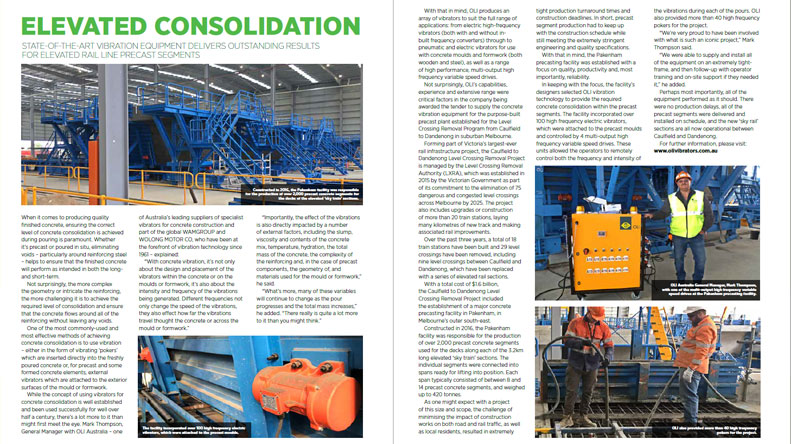Mark Thompson, General Manager at OLI Australia, has been interviewed by the magazine “Construction Engineering Australia”.
Here is a small abstract of the article:
ELEVATED CONSOLIDATION
STATE-OF-THE-ART VIBRATION EQUIPMENT DELIVERS OUTSTANDING RESULTS FOR ELEVATED RAIL LINE PRECAST SEGMENTS
When it comes to producing quality finished concrete, ensuring the correct level of concrete consolidation is achieved during pouring is paramount. Whether it’s precast or poured in situ, eliminating voids – particularly around reinforcing steel – helps to ensure that the finished concrete will perform as intended in both the longand short-term.
Not surprisingly, the more complex the geometry or intricate the reinforcing, the more challenging it is to achieve the required level of consolidation and ensure that the concrete flows around all of the reinforcing without leaving any voids.
One of the most commonly-used and most effective methods of achieving concrete consolidation is to use vibration – either in the form of vibrating ‘pokers’ which are inserted directly into the freshly poured concrete or, for precast and some formed concrete elements, external vibrators which are attached to the exterior surfaces of the mould or formwork.
While the concept of using vibrators for concrete consolidation is well established and been used successfully for well over
half a century, there’s a lot more to it than might first meet the eye. Mark Thompson, General Manager with OLI Australia – one
of Australia’s leading suppliers of specialist vibrators for concrete construction and part of the global WAMGROUP and WOLONG MOTOR CO, who have been at the forefront of vibration technology since 1961 – explained: “With concrete vibration, it’s not only about the design and placement of the vibrators within the concrete or on the moulds or formwork, it’s also about the intensity and frequency of the vibrations being generated. Different frequencies not only change the speed of the vibrations, they also effect how far the vibrations travel thought the concrete or across the mould or formwork.”

